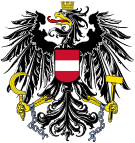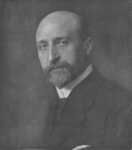1919 Austrian Constituent Assembly election
| |||||||||||||||||||||||||||||
All 170 seats in the Constituent Assembly 86 seats needed for a majority | |||||||||||||||||||||||||||||
|---|---|---|---|---|---|---|---|---|---|---|---|---|---|---|---|---|---|---|---|---|---|---|---|---|---|---|---|---|---|
| Turnout | 2,998,297 (84.4%) | ||||||||||||||||||||||||||||
| |||||||||||||||||||||||||||||
| |||||||||||||||||||||||||||||
| This article is part of a series on the |
| Politics of Austria |
|---|
 |
|
Constituent Assembly elections were held in Austria on 16 February 1919,[1] and were the first election in which all women were allowed to vote.[2] German citizens living in Austria and Sudeten Germans living in the newly-formed Czechoslovakia were also allowed to vote in the elections, despite Czechoslovak objections. Austrian citizens living in Germany were also allowed to vote in the elections for the Weimar National Assembly in the same year.[3]
The Social Democratic Workers' Party emerged as the largest party, winning 72 of the 170 seats.[4] The party was largely supported by the working class, whilst farmers and the middle class voted mainly for the anti-Anschluss Christian Social Party.[5] Voter turnout was 84.4%.
The first meeting of the assembly was on 4 March 1919. The Sudeten German Social Democrats organised a series of demonstrations in support of their right of self-determination. Across seven cities 54 persons were killed and another 84 wounded by the Czech military and police.[6]
The two main parties, the SDAPÖ and the CS, formed a coalition government after the elections. Although it had broken up by mid-1920, a new constitution was agreed on 1 October 1920.[5] Fresh elections were held on 17 October.
Results[]
| Party | Votes | % | Seats | |
|---|---|---|---|---|
| Social Democratic Workers' Party | 1,211,393 | 40.76 | 72 | |
| Christian Social Party | 687,465 | 23.13 | 47 | |
| 222,304 | 7.48 | 12 | ||
| German Nationals Party | 174,738 | 5.88 | 8 | |
| 67,396 | 2.27 | 1 | ||
| German Democrats | 64,073 | 2.16 | 3 | |
| 62,099 | 2.09 | 0 | ||
| German People's Party | 59,919 | 2.02 | 2 | |
| German Freedom and Order Party | 56,306 | 1.89 | 5 | |
| 50,361 | 1.69 | 3 | ||
| Centrist Democrats | 48,995 | 1.13 | 1 | |
| Styrian Farmers' Party | 47,021 | 1.58 | 3 | |
| National Democratic Party | 46,507 | 1.56 | 0 | |
| Carinthian Farmers' Association | 33,496 | 1.13 | 2 | |
| 46,030 | 1.55 | 7 | ||
| National-Socialist Workers' Party | 23,252 | 0.78 | 0 | |
| German Peoples' Election Committee | 15,430 | 0.52 | 1 | |
| Democrats | 15,053 | 0.51 | 0 | |
| Democratic Association of Cities | 12,336 | 0.41 | 1 | |
| Liberal Corporate Association of Salzburg | 8,507 | 0.29 | 1 | |
| Jewish National Party | 7,770 | 0.26 | 1 | |
| Democratic Middle-class Party | 5,960 | 0.20 | 0 | |
| Democratic Economic Party | 3,828 | 0.13 | 0 | |
| 1,645 | 0.05 | 0 | ||
| Economic People's Party | 411 | 0.01 | 0 | |
| Invalid/blank votes | 25,239 | – | – | |
| Total | 2,997,534 | 100 | 170 | |
| Registered voters/turnout | 3,547,742 | 84.49 | – | |
| Source: Government of Austria | ||||
Notes[]
- ^ , , and
References[]
- ^ Nohlen, Dieter; Stöver, Philip (31 May 2010). Elections in Europe: A data handbook. Nomos Verlagsgesellschaft. p. 196. ISBN 978-3-8329-5609-7.
- ^ "85 Jahre allgemeines Frauenwahlrecht in Österreich". 2011-03-06. Archived from the original on 2011-03-06. Retrieved 2019-06-14.
- ^ AUSTRIA VOTES TODAY. - German Part of Former Dual Monarchy Chooses Its Constituent Assembly., The New York Times, February 16, 1919 (PDF)
- ^ Graham, Malbone W. (1930). "Foreign Governments and Politics: The Constitutional Crisis in Austria". The American Political Science Review. 24 (1): 144–157. doi:10.2307/1946794. JSTOR 1946794.
- ^ a b Nohlen & Stöver, p173
- ^ Suppan, Arnold. "Austrians, Czechs, and Sudeten Germans as a Community of Conflict in the Twentieth Century" (PDF). conservancy.umn.edu. Center for Austrian Studies, Minnesota. Retrieved 8 February 2018.
- 1919 elections in Austria
- Elections in Austria
- February 1919 events




